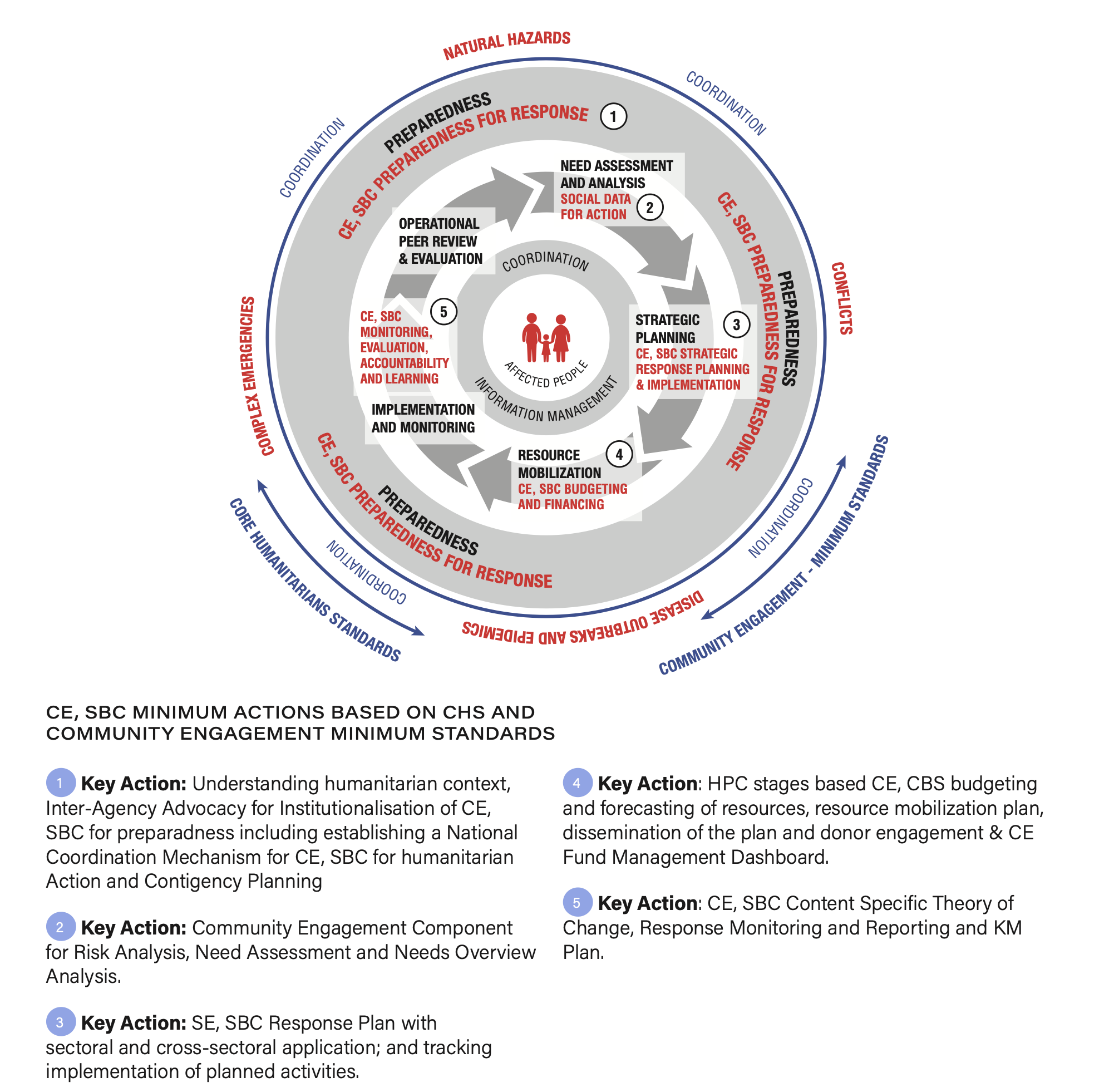
SBC in the Humanitarian Cycle
Using the Community Engagement in Humanitarian Action Toolkit (CHAT)
Introduction
The Community Engagement in Humanitarian Action Toolkit – CHAT – is an effort to bring holistic programming guidance that addresses Community Engagement (CE) needs for natural hazards, conflicts, disease outbreaks and epidemics, and complex emergencies. The current version of CHAT (June 2023) is an updated, more relevant and modern resource.
A compendium of guidance and practical tools, it is aligned with the latest global frameworks, policies and standards, and builds on existing CE resources, guidance and tools available since 2014. It helps countries and stakeholders to mount contextualised humanitarian preparedness and response efforts, and to gradually build local capacities to mitigate the impacts on people’s lives, health and well-being as they grapple with complex social and economic factors.
You can access the CHAT report here!
New elements of CHAT
The updated CHAT aligns CE programming to humanitarian programming and systematically advocates for preventing risks, building social cohesion and strengthening resilience, with an increased role for local communities and civil society.
The new elements in the 2023 version of CHAT include:
1 | CHAT is a comprehensive guidance with tools for high-quality community engagement for Social and Behaviour Change in humanitarian action. It provides a strategic shift for renewed focus to scale-up CE, SBC within humanitarian action. Moving away from generic guidance and addressing high-quality programming needs across emergencies, the toolkit has full CE, SBC guidance tailored to provide relevant, timely, people-centred interventions in natural hazards, armed conflicts and disease outbreaks and epidemics. |
2 | CHAT is aligned with global community engagement minimum standard guidance and Core Humanitarian Standards (CHS). The toolkit brings understanding and interoperability between standards and legal frameworks and humanitarian programming guidance (Sphere Standards, Core Commitment of Children in Humanitarian Action) to define CE actions. It highlights clear linkages with CHS and CEMS and includes a joint advocacy agenda, for partners to improve community engagement practices at scale by linking the humanitarian and development nexus. |
3 | CHAT mainstreams CE, SBC actions throughout the Humanitarian Programming Cycle. It Includes a Collective Action Framework that provides interactive resources, tools and guidance linking CE actions for all elements of HPC. It includes needs assessment and analysis, strategic response planning, resource mobilisation, implementation and monitoring, operational review and evaluation. It provides guidance for applicability across sectors and cross-sectors to address the needs of communities affected by crisis. This is to ensure community engagement is well integrated within the humanitarian architecture and not seen as an afterthought.
 |
4 | CHAT is a guidance for systematic use of social data for action. Social science has become an important and critical component of CE in the crisis context. CHAT provides extensive guidance and tools to use community feedback and improve insights and analysis, with explicit focus on social, cultural and structural behavioural determinants. It provides resources for use of evidence for influencing policies and making humanitarian interventions more accountable to the communities they serve. |
5 | CHAT is a resource of good practices. It draws attention to country examples that demonstrate successful application of CE and learnings from different crisis contexts. It is designed as an evolving document that will continue to build on its resources and narrative, based on experiences of partners working in the CE, SBC area. |
Key users of CHAT
CHAT serves as a programming guidance to scale up contextualised and localised CE, SBC actions during a crisis. It is meant for the following key stakeholders:
- Humanitarian practitioners within national governments and civil society organisations
- Experts leading and working on CE, SBC interventions
- Leaders of humanitarian organisations and heads of humanitarian programmes and inter-agency networks building capacity at individual and organisational level
- Donors
Application and implementation of CHAT
CHAT is designed to comprehensively address CE, SBC needs in humanitarian action. The current humanitarian context continues to be challenging, without enough time for proper planning, implementation, monitoring and documentation of CE interventions. The CHAT toolkit provides a rich repertoire of resources, guidance and tools that can be adapted to most humanitarian settings. It is an easy-to-use, navigable toolkit that comes in a tabulated-pull-out format.
The CHAT toolkit is divided into six sections:
Section 1: Overview and introduction | Section 1.1 introduces CHAT, shares who it is meant for and explains how to use it. Section 1.2 explains CE, SBC and its role in Humanitarian Action, Accountability to Affected Populations and Community Engagement linkages for the field. It outlines global policies, frameworks and standards to which CHAT has been aligned and presents a CE,SBC Common Action Framework based on Community Engagement Minimum Standards and CHS. |
Section 2: Community Engagement for natural hazards | Section 2 presents a comprehensive package that covers CE, SBC resources, tools and guidance to address geo-physical, hydro-meteorological and climatological hazards. It includes the global programming framework, advocacy guidance for institutionalisation of CE,SBC for natural hazards, coordination mechanism, social data for action with guidance for risk analysis and needs assessment, CE,SBC plan with sectoral and cross-sectoral application and Monitoring and Evaluation (M&E). Additional guidance is provided on media engagement, documentation and knowledge management. It ends with a checklist that allows users to track processes and tools while planning and implementing their CE,SBC initiatives. |
Section 3: Community Engagement for conflicts | Section 3 deals with armed conflict and provides resources, tools and guidance to mainstream community engagement for peacebuilding. It includes a global programming framework for preventing conflicts, advocacy for institutionalisation for CE,SBC for sustaining peace, coordination mechanism, social data for action which includes guidance for conflict analysis and conflict needs assessment, a CE,SBC plan with youth for peace, sectoral and cross-sectoral application and M&E. There is additional guidance on media engagement, documentation and knowledge management. It ends with a checklist that allows users to track processes and tools while planning and implementing their CE,SBC initiatives. |
Section 4: Risk communication and Community Engagement (RCCE) for disease outbreaks and epidemics | Section 4 describes key elements and provides resources, tools and guidance for disease outbreaks and epidemic management. It explains 15 deadly diseases of the century and reinforces preparedness and response around prioritised risks. It provides advocacy guidance for institutionalisation of Risk Communication and Community Engagement (RCCE), shares details about the national RCCE coordination mechanisms, social data for action including behavioural surveillance and a rapid Knowledge, Attitude and Practices (KAP) and RCCE planning process with sectoral and cross-sectoral application. It provides inputs and resources for “Infodemic management” and effective media engagement. |
Section 5: Community Engagement for complex emergencies | Section 5 explains complex emergencies and their characteristics with several ‘how-to’ tools. It covers issues such as migration crisis where CE,SBC can play an important role. This section provides guidance for ‘response only’ (and does not include preparedness) for new emergencies. For on-going conflict emergencies, use section 3 to develop and implement comprehensive CE,SBC interventions (from preparedness to response). |
Section 6: Integrating CE, SBC and HPC within UNICEF Country Programme Planning and Analysis | Section 6 sets the foundation for an organisation-wide, standardised set of steps that can align with CE,SBC actions as outlined in the HPC with UNICEF Country Programme Planning and Analysis processes. For coherent programming, the CE,SBC actions are completely integrated within the Humanitarian Programme Cycle (HPC) programmatically and operationally across its elements. |
The CE, SBC Collective Action Framework has been used as a template to guide the structure of the sections of the CHAT, with the exception of RCCE. The structure is illustrated below.
10-step process for using the CHAT toolkit
Steps 1-4: CE preparedness for response
Step 1 | Select the humanitarian section based on country context. Familiarise yourself with Section 1: the introduction covers the structure of CHAT and the overview covers the role of CE, SBC, linkages with AAP, overall standards, frameworks and a common intervention framework. |
Step 2 | Understand the humanitarian context and ensure preparedness. Seek more context-specific details to guide standards, programme framework and linkages with CE, SBC. Plan and prepare for CE, SBC based on a common action framework before occurrence of any emergency or disaster. Include a contingency plan to help stakeholders acquire an advanced level of readiness for specific humanitarian contexts. |
Step 3 | Advocate for institutionalisation of CE, SBC/RCCE. Ensure timely advocacy and building of CE, SBC systems so that they are well mainstreamed across all phases of humanitarian programming. |
Step 4 | Establish a CE, SBC/RCCE national coordination mechanism under the aegis of the government. Include UN agencies, NGOs, in-country donor organisations and humanitarian agencies. Include civil society organisations to represent marginalised and vulnerable groups, and have in place a sustained collaborative arrangement with key stakeholders. |
Steps 5: CE,SBC data for action
Step 5 | Engage in robust CE,SBC data for action, including community feedback, and use it to inform CE, SBC interventions across the HPC. Make every effort to include the most deprived communities. |
Steps 6 & 7: Strategic CE response planning & implementation
Step 6 | Develop a CE, SBC plan that caters to the Humanitarian Programme Cycle (HPC). Follow guidance to develop a comprehensive plan in advance to address CE, SBC needs for all phases of HPC. Adjust response, early recovery and recovery components based on needs assessment and additional community feedback. Establish CE sectoral commitments based on Sphere Standards and CCCs and cross-sectoral linkages. Ensure that the CE, SBC plan builds on behavioural outcomes aligned to sectoral results. As part of the planning process, address vulnerabilities related to age, gender and socio-economic status. |
Implementation must focus on providing life-saving information, promoting critical behaviours and re-establishing positive/new social and cultural values. The implementation of the plan must be guided by CHS and Community Engagement Minimum Standards. A mixed-channel approach will be required, to ensure no one is left behind. | |
Step 7 | Make media an ally and collaborate from the start. This will enhance the trust factor and build relationships with institutions during peacetime. The healthy relationship will go a long way towards mitigating myths, misconceptions and fake information that can be detrimental to managing any humanitarian crisis. |
Step 8: Budgeting for CE
Step 8
| Initiate budgeting for CE, SBC resources as soon as preparedness measures and contingency plans are ready. Based on CE preparedness and response planning, develop a resource mobilisation plan and strategically invest to deliver on collective CE, SBC results. At the onset of a crisis, share the mobilisation plan with partners and disseminate after making adjustments. Also ensure that collective fund tracking mechanisms are in place under the national coordination group, for judicious use of resources and management of field interventions. |
Steps 9 & 10: Monitoring, evaluation, accountability and learning
Step 9 | CE, SBC monitoring, evaluation, accountability and learning systems are established to frame evidence-generation activities as part of preparedness measures and the response planning and implementation process. Regular monitoring and evaluation of CE, SBC indicators is required even if circumstances surrounding the crisis are grave and complex, as this helps in assessing CE interventions’ links to humanitarian actions. It also reviews how these actions support the achievement of behavioural results such as protective practices and service-seeking behaviours, and provides critical information on behavioural determinants and drivers that must be taken into account when developing CE, SBC humanitarian programmes, so that they remain adaptable and agile for sectors/clusters. Ensure that the M&E approach is inclusive and engages affected communities actively, with age, gender and disability perspectives made integral as part of results. Roll out a knowledge management plan with allocated resources concurrently followed by documentation of learnings, to guide future CE, SBC preparedness and response. |
Step 10 | Use the checklist provided at the end of the sections to track CE, SBC programme actions and use of relevant tools, to ensure high-quality programming. |

Do - SBC in the Humanitarian Cycle
Download this article as a PDF
You can download the entire page as a PDF here






